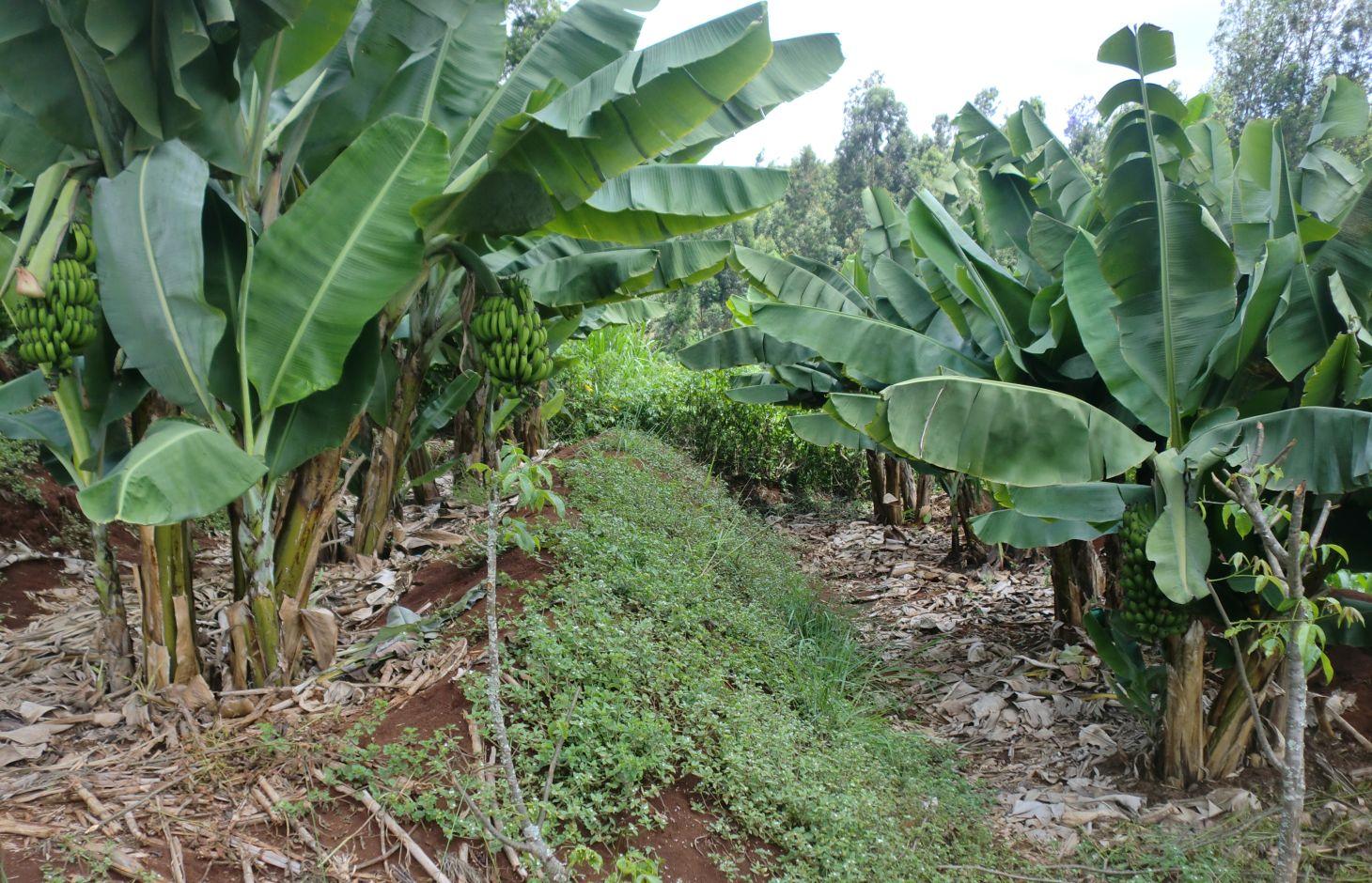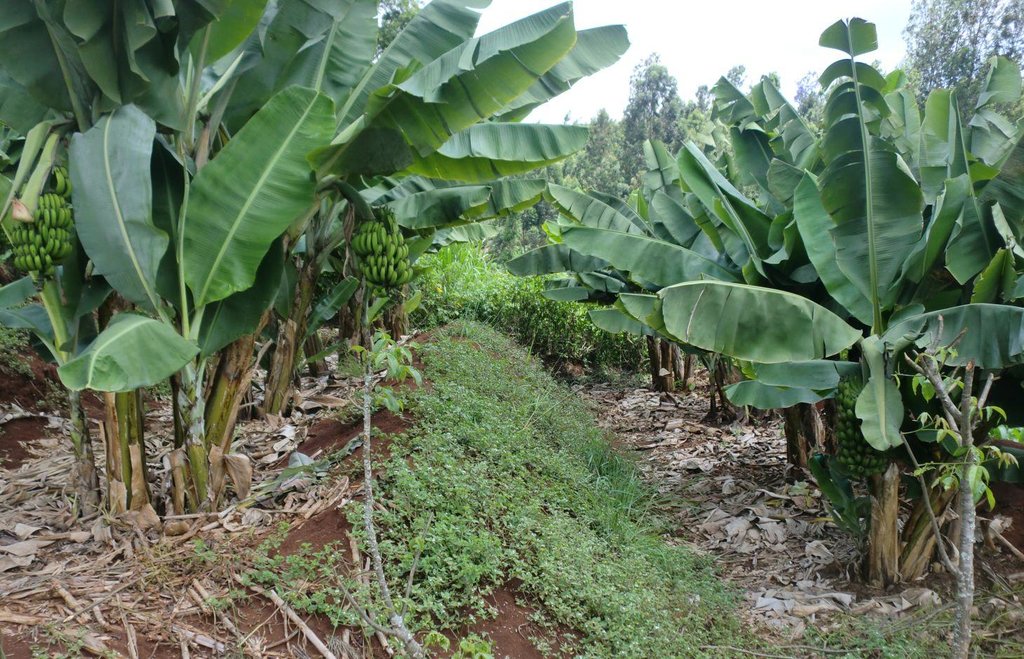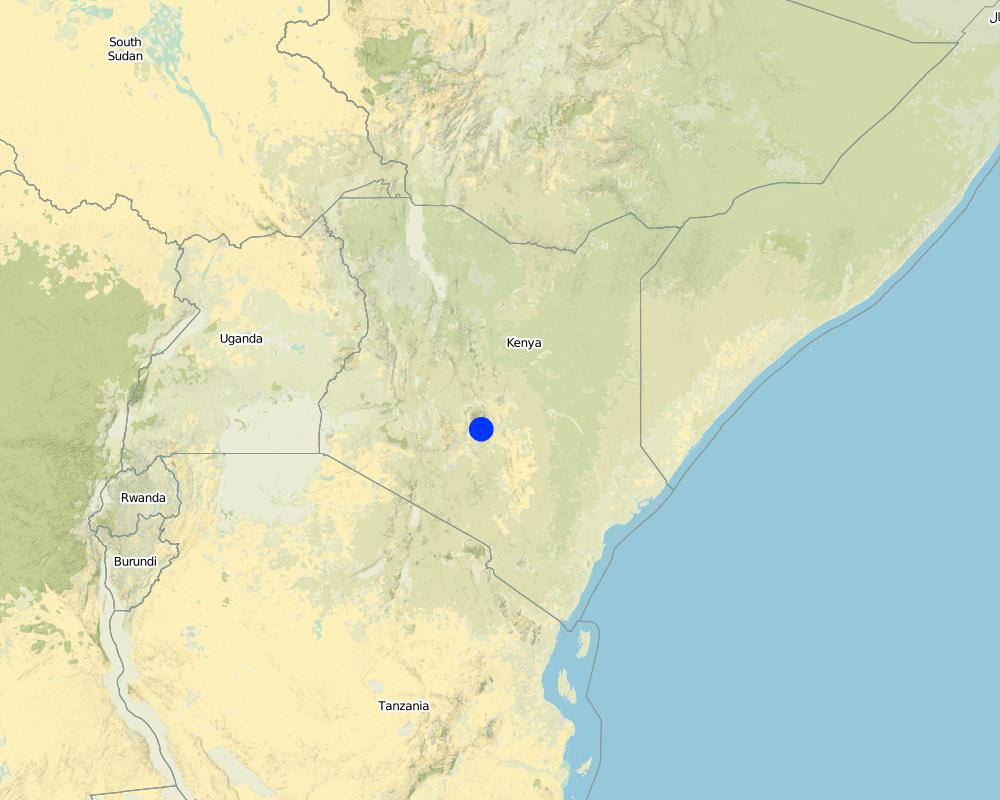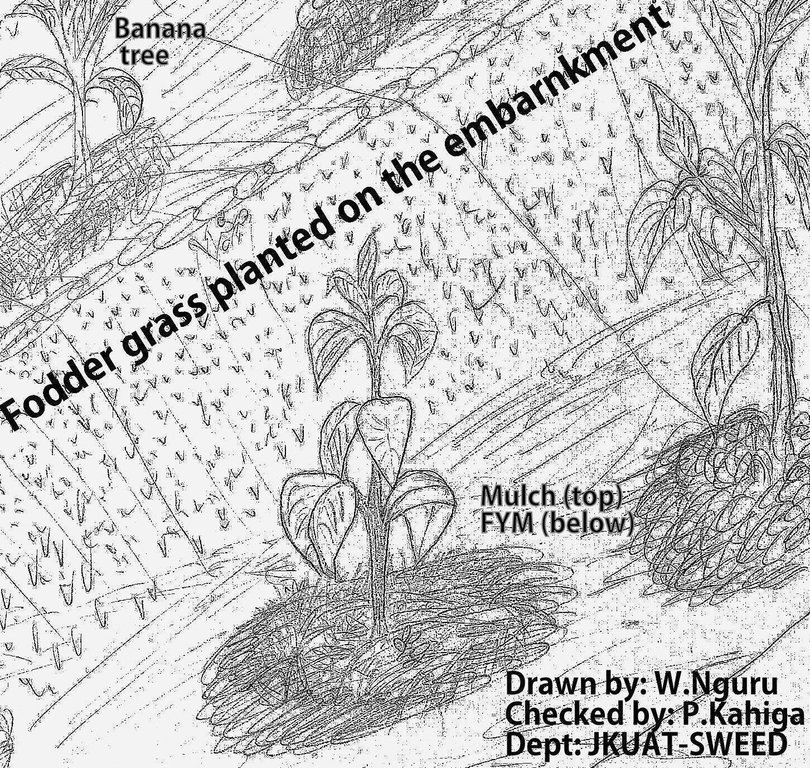Mulching [肯尼亚]
- 创建:
- 更新:
- 编制者: Paul Kahiga
- 编辑者: –
- 审查者: Fabian Ottiger, Alexandra Gavilano
Mulching
technologies_1318 - 肯尼亚
查看章节
全部展开 全部收起1. 一般信息
1.2 参与该技术评估和文件编制的资源人员和机构的联系方式
SLM专业人员:
Gathenya Mwangi
Jomo Kenyatta University of Agriculture and Technology
肯尼亚
SLM专业人员:
Home Patrick
Jomo Kenyatta University of Agriculture and Technology
肯尼亚
SLM专业人员:
Chege Timothy
Jomo Kenyatta University of Agriculture and Technology
肯尼亚
SLM专业人员:
Wamuongo Jane
Kenya Agricultural Research Institute
肯尼亚
SLM专业人员:
Karanja Andrew
Kenya Agricultural Research Institute
肯尼亚
有助于对技术进行记录/评估的机构名称(如相关)
Jomo Kenyatta University (Jomo Kenyatta University) - 肯尼亚有助于对技术进行记录/评估的机构名称(如相关)
KARI Headquarters (KARI Headquarters) - 肯尼亚1.3 关于使用通过WOCAT记录的数据的条件
编制者和关键资源人员接受有关使用通过WOCAT记录数据的条件。:
是
1.4 所述技术的可持续性声明
这里所描述的技术在土地退化方面是否存在问题,导致无法被认为是一种可持续的土地管理技术?:
否
2. SLM技术的说明
2.1 技术简介
技术定义:
Mulching is done by covering the soil surface between crop rows, around trees (mostly fruit and orchard) or vegetables with cut grass, crop residues, straw or other plant material in order to retain soil moisture, prevent or suppress weed growth and enhance soil structure.
2.2 技术的详细说明
说明:
A layer of crop residues, cut grass, straw or other plant material is spread on the soil surface between crop rows or around the vegetables or orchard trees in order to retain the soil moisture by limiting evaporation, prevents weed growth and enhances soil structure. Farmers in the Upper Tana Catchment mostly uses crop residues as mulch especially after the harvesting season. Banana leaves in Embu county are used as mulch on banana plants.
Purpose of the Technology: Mulching is mostly used in the Upper Tana Catchment to retain soil moisture by limiting evaporation, it also prevents weed growth and enhances soil structure. It is commonly used in areas that are mostly affected by drought and weed infestation. In Embu District, mulch on banana plantations is supplemented with farm yard manure as shown in the photographs above. The most readily available source of mulching materials is banana leaves themselves even though other type of mulch materials are also in use. Some farmers use the these leaves both as mulch and as livestock feeds during the drought seasons.
Establishment / maintenance activities and inputs: The mulch layer is rougher than the surface of the soil and thus inhibits runoff. The layer of plant material protects the soil from splash erosion and limits the formation of soil crust. It is worth to note that the choice of mulch depends on locally available materials. In alley-cropping systems, hedgerow biomass is often used as mulch. Another strategy is to leave crop residues, such as maize stalks on the ground after harvesting. Mulch can be spread on a seedbed or around planting holes. Large pieces of crop residues should be cut into smaller pieces before spreading on the soil's surface. There are many advantages of using mulch which include, increase of soil moisture, reduction of excessive evaporation from the soil surface, suppression of weeds which further reduces labour cost of weeding. Mulching reduces high fluctuations in soil temperature, which means improved conditions for microorganisms in the soil. It also increases soil organic matter and thereby improves soil structure. Mulch protects the soil against splash erosion and runoff. The disadvantages of mulch includes the following; unavailability of suitable materials for mulch, some seeds of mulch might germinate and become weed problem. If crop residues are used as mulch it might mean a loss of animal fodder. Especially in the drier parts of Mbeere district, dry mulch has been reported as fire hazard. Sometimes it is difficult to spread mulch on steep slopes and it can also be a possible habitat for pests and diseases.
Natural / human environment: Areas with limited rainfall usually respond very well to mulching. Mulching is not applicable in wet conditions however, the soils should have good drainage.
2.3 技术照片
2.5 已应用该技术的、本评估所涵盖的国家/地区/地点
国家:
肯尼亚
区域/州/省:
Eastern Province
有关地点的进一步说明:
Embu North District
具体说明该技术的分布:
- 均匀地分布在一个区域
如果不知道精确的区域,请注明大致覆盖的区域:
- 1-10 平方千米
注释:
Most of the farmers use mulch from their crop residuals
Map
×2.6 实施日期
如果不知道确切的年份,请说明大概的日期:
- 10-50年前
2.7 技术介绍
详细说明该技术是如何引入的:
- 通过土地使用者的创新
3. SLM技术的分类
3.1 该技术的主要目的
- 改良生产
- 保护生态系统
- 保持/提高生物多样性
- 创造有益的经济影响
3.2 应用该技术的当前土地利用类型

农田
- 一年一作
- 多年一作(非木材)
- 乔木与灌木的种植
年作 - 具体指明作物:
- 谷物类 - 玉米
- 饲料作物 - 草
- 蔬菜 - 其他
多年生(非木质)作物 - 指定作物:
- 香蕉/芭蕉/蕉麻
- coffee
每年的生长季节数:
- 2
具体说明:
Longest growing period in days: 180, Longest growing period from month to month: April to October
注释:
Major land use problems (compiler’s opinion): Soil erosion, weed infestation and excessive evaporation in the farm lands
Major land use problems (land users’ perception): Low soil fertility and excessive evaporation of soil moisture
3.4 供水
该技术所应用土地的供水:
- 雨养
3.5 该技术所属的SLM组
- 改良的地面/植被覆盖
3.6 包含该技术的可持续土地管理措施

农艺措施
- A2:有机质/土壤肥力
注释:
Type of agronomic measures: mulching, manure / compost / residues
3.7 该技术强调的主要土地退化类型

土壤水蚀
- Wt:表土流失/地表侵蚀

化学性土壤退化
- Cn:肥力下降和有机质含量下降(非侵蚀所致)
注释:
Main causes of degradation: crop management (annual, perennial, tree/shrub)
Secondary causes of degradation: soil management, deforestation / removal of natural vegetation (incl. forest fires), overgrazing
3.8 防止、减少或恢复土地退化
具体数量名该技术与土地退化有关的目标:
- 防止土地退化
- 减少土地退化
4. 技术规范、实施活动、投入和成本
4.1 该技术的技术图纸
技术规范(与技术图纸相关):
The technical drawing on the left shows banana trees planted on benches. Fodder grass that is used to feed livestock is planted to stabilize the slopes. FYM is first spread at the base and latter covered with mulch made from the banana leaves.
Location: Embu North. Eastern Province
Date: 06/09/2016
Technical knowledge required for field staff / advisors: low
Technical knowledge required for land users: high
Main technical functions: control of raindrop splash, control of dispersed runoff: retain / trap, improvement of ground cover, increase of infiltration
Secondary technical functions: control of dispersed runoff: impede / retard, control of concentrated runoff: retain / trap, increase of surface roughness, increase in organic matter, increase of groundwater level / recharge of groundwater, reduction in wind speed
Mulching
Material/ species: Banana leaves
Quantity/ density: 2
Remarks: mulch is spread on the surface surrounding the banana trees
Manure / compost / residues
Material/ species: Farmyard Manure
Quantity/ density: 1
Remarks: Farm yard manure is first applied around the banana tree then the mulch is spread over
作者:
Paul Kahiga, 62000-00200 Nairobi
4.2 有关投入和成本计算的一般信息
其它/国家货币(具体说明):
Kshs.
如相关,注明美元与当地货币的汇率(例如1美元=79.9巴西雷亚尔):1美元=:
100.0
注明雇用劳工的每日平均工资成本:
400.00
4.3 技术建立活动
| 活动 | 时间(季度) | |
|---|---|---|
| 1. | Apply banana leaves and FYM |
注释:
Lifespan of the leaves: 1 year
4.4 技术建立所需要的费用和投入
| 对投入进行具体说明 | 单位 | 数量 | 单位成本 | 每项投入的总成本 | 土地使用者承担的成本% | |
|---|---|---|---|---|---|---|
| 劳动力 | Labour | ha | 1.0 | 50.0 | 50.0 | 100.0 |
| 设备 | Tools | ha | 1.0 | 10.0 | 10.0 | 100.0 |
| 肥料和杀菌剂 | Compost/manure | ha | 1.0 | 10.0 | 10.0 | 100.0 |
| 技术建立所需总成本 | 70.0 | |||||
| 技术建立总成本,美元 | 0.7 | |||||
注释:
Duration of establishment phase: 1 month(s)
4.5 维护/经常性活动
| 活动 | 时间/频率 | |
|---|---|---|
| 1. | Cutting the banana leaves and applying FYM | one in every six months |
4.6 维护/经常性活动所需要的费用和投入(每年)
| 对投入进行具体说明 | 单位 | 数量 | 单位成本 | 每项投入的总成本 | 土地使用者承担的成本% | |
|---|---|---|---|---|---|---|
| 劳动力 | Cutting the banana leaves and applying FYM | ha | 1.0 | 4.0 | 4.0 | 100.0 |
| 设备 | Tools | ha | 1.0 | 10.0 | 10.0 | 100.0 |
| 肥料和杀菌剂 | Compost/manure | ha | 1.0 | 5.0 | 5.0 | 100.0 |
| 技术维护所需总成本 | 19.0 | |||||
| 技术维护总成本,美元 | 0.19 | |||||
注释:
Machinery/ tools: Pangas to cut the leaves, shovels and wheels barrows to carry the FYM
number of mulched banana plants
4.7 影响成本的最重要因素
描述影响成本的最决定性因素:
Labour and availability of mulch determines the cost of the technology
5. 自然和人文环境
5.1 气候
年降雨量
- < 250毫米
- 251-500毫米
- 501-750毫米
- 751-1,000毫米
- 1,001-1,500毫米
- 1,501-2,000毫米
- 2,001-3,000毫米
- 3,001-4,000毫米
- > 4,000毫米
农业气候带
- 半湿润
5.2 地形
平均坡度:
- 水平(0-2%)
- 缓降(3-5%)
- 平缓(6-10%)
- 滚坡(11-15%)
- 崎岖(16-30%)
- 陡峭(31-60%)
- 非常陡峭(>60%)
地形:
- 高原/平原
- 山脊
- 山坡
- 山地斜坡
- 麓坡
- 谷底
垂直分布带:
- 0-100 m a.s.l.
- 101-500 m a.s.l.
- 501-1,000 m a.s.l.
- 1,001-1,500 m a.s.l.
- 1,501-2,000 m a.s.l.
- 2,001-2,500 m a.s.l.
- 2,501-3,000 m a.s.l.
- 3,001-4,000 m a.s.l.
- > 4,000 m a.s.l.
5.3 土壤
平均土层深度:
- 非常浅(0-20厘米)
- 浅(21-50厘米)
- 中等深度(51-80厘米)
- 深(81-120厘米)
- 非常深(> 120厘米)
土壤质地(表土):
- 中粒(壤土、粉土)
表土有机质:
- 高(>3%)
如有可能,附上完整的土壤描述或具体说明可用的信息,例如土壤类型、土壤酸碱度、阳离子交换能力、氮、盐度等。:
Soil fertility: Medium
Soil drainage/infiltration: Good
Soil water storage capacity: Medium
5.4 水资源可用性和质量
地下水位表:
5-50米
地表水的可用性:
好
水质(未处理):
良好饮用水
5.5 生物多样性
物种多样性:
- 高
5.6 应用该技术的土地使用者的特征
生产系统的市场定位:
- 混合(生计/商业)
非农收入:
- 低于全部收入的10%
相对财富水平:
- 平均水平
个人或集体:
- 个人/家庭
机械化水平:
- 手工作业
- 机械化/电动
性别:
- 女人
- 男人
说明土地使用者的其他有关特征:
Land users applying the Technology are mainly common / average land users
Difference in the involvement of women and men: no
Population density: 10-50 persons/km2
Annual population growth: 0.5% - 1%
Off-farm income specification: Few farmers have shops/kiosks that they use to supplement their income other than farming
5.7 应用该技术的土地使用者使用的平均土地面积
- < 0.5 公顷
- 0.5-1 公顷
- 1-2 公顷
- 2-5公顷
- 5-15公顷
- 15-50公顷
- 50-100公顷
- 100-500公顷
- 500-1,000公顷
- 1,000-10,000公顷
- > 10,000公顷
这被认为是小规模、中规模还是大规模的(参照当地实际情况)?:
- 小规模的
5.8 土地所有权、土地使用权和水使用权
土地所有权:
- 个人,有命名
土地使用权:
- 个人
用水权:
- 个人
5.9 进入服务和基础设施的通道
健康:
- 贫瘠
- 适度的
- 好
教育:
- 贫瘠
- 适度的
- 好
技术援助:
- 贫瘠
- 适度的
- 好
就业(例如非农):
- 贫瘠
- 适度的
- 好
市场:
- 贫瘠
- 适度的
- 好
能源:
- 贫瘠
- 适度的
- 好
道路和交通:
- 贫瘠
- 适度的
- 好
饮用水和卫生设施:
- 贫瘠
- 适度的
- 好
金融服务:
- 贫瘠
- 适度的
- 好
6. 影响和结论性说明
6.1 该技术的现场影响
社会经济效应
生产
作物生产
生产故障风险
收入和成本
农业投入费用
农业收入
社会文化影响
SLM/土地退化知识
Improved livelihoods and human well-being
注释/具体说明:
It has contributed to soil erosion control through improved ground cover, reduction of splash by rain drops. Improved soil fertility and moisture content of the top soil and increase of yield.
生态影响
水循环/径流
蒸发
土壤
土壤水分
土壤覆盖层
生物多样性:植被、动物
害虫/疾病控制
注释/具体说明:
Rats and squeals can hide in the mulch before decomposition
6.2 该技术的场外影响已经显现
下游洪水
下游淤积
6.3 技术对渐变气候以及与气候相关的极端情况/灾害的暴露和敏感性(土地使用者认为的极端情况/灾害)
渐变气候
渐变气候
| 季节 | 增加或减少 | 该技术是如何应对的? | |
|---|---|---|---|
| 年温度 | 增加 | 好 |
气候有关的极端情况(灾害)
气象灾害
| 该技术是如何应对的? | |
|---|---|
| 局地风暴 | 好 |
气候灾害
| 该技术是如何应对的? | |
|---|---|
| 干旱 | 好 |
水文灾害
| 该技术是如何应对的? | |
|---|---|
| 比较和缓的(河道)洪水 | 未知 |
注释:
Addition of FYM before the mulch enhances retaining of moisture
6.4 成本效益分析
技术收益与技术建立成本相比如何(从土地使用者的角度看)?
短期回报:
积极
长期回报:
积极
技术收益与技术维护成本/经常性成本相比如何(从土地使用者的角度看)?
短期回报:
积极
长期回报:
积极
注释:
After decomposition, the rich organic matter and nutrients remains in the soil for long time.
6.5 技术采用
注释:
There is a moderate trend towards spontaneous adoption of the Technology
6.7 该技术的优点/长处/机会
| 土地使用者眼中的长处/优势/机会 |
|---|
| Crop materials for mulch are available on site i.e banana leaves |
| 编制者或其他关键资源人员认为的长处/优势/机会 |
|---|
| Mulch in banana plantations is generally easy to be established and to maintain. |
| Mulch in banana plantations reduces rain drop's splashing energy thus reduces loss of top soil which could occur due to splash of the rain drops. |
| After sometime, the mulch materials eventually rots and becomes manure thus improving soil organic matter |
6.8 技术的弱点/缺点/风险及其克服方法
| 土地使用者认为的弱点/缺点/风险 | 如何克服它们? |
|---|---|
| Habours termites and pests before complete decomposition. | Use of biodegradable insecticides incase of infestation of termites and other pests. |
| 编制者或其他关键资源人员认为的弱点/缺点/风险 | 如何克服它们? |
|---|---|
| In absence of other supplemental materials, mulch in banana plantations requires regular replacement due to continuous decomposition. | supplementing of the banana leaves with other crop residues. |
7. 参考和链接
7.1 信息的方法/来源
- 实地考察、实地调查
- 与土地使用者的访谈
(现场)数据是什么时候汇编的?:
09/02/2011
链接和模块
全部展开 全部收起链接
无链接
模块
无模块






